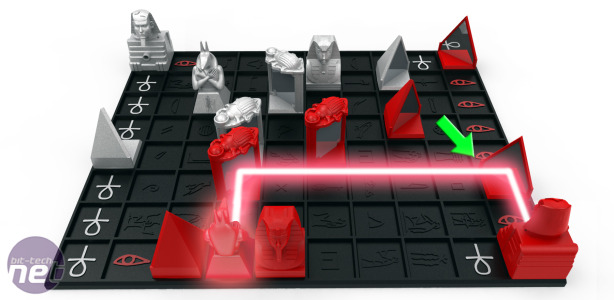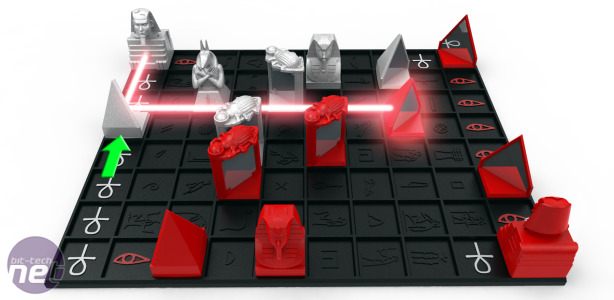
Khet 2.0 Review
Publisher: Innovention ToysUK price (as reviewed): £31.99 (inc VAT)
US price (as reviewed): $34.99 (ex tax)
Players: Two
Khet is one of the most easily understood and analogised games ever; it’s a bit like Chess with lasers, right? That’s what it looks like and, as it happily turns out, that’s kind of how it plays too.
The rules are simple. Each player takes a colour, with Silver going first. Nearly all pieces move in the same way – one 90 degree rotation or one square in any direction – and you get one move per turn. At the end of your turn, you have to fire your laser. The aim of the game is to try to hit your opponent's Pharaoh with your laser beam, killing it. If you hit a piece on anything other than its mirror, that piece is removed from the board.
There are a few exceptions to bear in mind – Red pieces can’t go on Silver squares and Scarabs can be swapped with adjacent pieces, for example – but that’s about all there is to it. It's simple and straightforward, with the added benefit of lasers.
However, while the rules are as easy to grasp as a fistful of dough, there’s still plenty of complexity built into the game itself. That’s especially true if you misread the flimsy double-sided rulebook and spend your first five games trying to attack Sphinxes rather than the Pharaoh, which is what happened to us. For most people, though, the complexity will come from having to constantly trace where the laser-beam will eventually land and how it can be manipulated across the board.
This doesn’t sound like a difficult task, but as Khet 2.0 develops beyond whichever of the three starting layouts you've chosen from the rules, it certainly becomes so. In every move you have to take both you and your opponent's laser into account, as well as how your enemy will manipulate it in the next turn. What's more, this all has to be done without activating the laser itself, which can only be turned on at the end of the turn.
As with all tactical two-player games, though, the amount of fun to be eked out of the game is dependent on your opponent. On more than one occasion we played games that became wholly one-sided when one player turned their own laser so that it shined off the board, removing it from the game. This essentially simplified the board to the degree that the other player was forced into a constant defence, prolonging the game hugely and whittling away fun.
The other drawback to bear in mind is that, while games eventually evolve uniquely, there are only three starting positions included in the rulebook. You can easily make up your own variations, sure, but it would have been better to have had some more advanced layouts on offer. Once players have grasped the basics, the first few moves tend to always unfold similarly, as there aren’t enough uniquely powered pieces to rapidly advance the game (as there are in, say, Chess).
However, to get bogged down in complaints such as these is to overlook a fun and well-designed game. It’s quick to pick up, but tough to master – something that’s universally said for all of the really classic games, be they electronic, physical or involving Sphinxes that shoot frickin’ laser beams out of their heads. It's just a shame that it doesn't pack enough competitive punch or per-game longevity for us to label it as a 'must have'.
While there may be ways to improve Khet 2.0 beyond what’s offered in the vanilla box, as demonstrated by an expansion that adds a tower to the centre of the board, it’s also possible these changes could overcomplicate or ruin the game. It’s far better to sit back and recognise Khet 2.0 for what it is – Chess for a generation that needs all its entertainment to be visually arresting.
-
Overall80 / 100


MSI MPG Velox 100R Chassis Review
October 14 2021 | 15:04











Want to comment? Please log in.